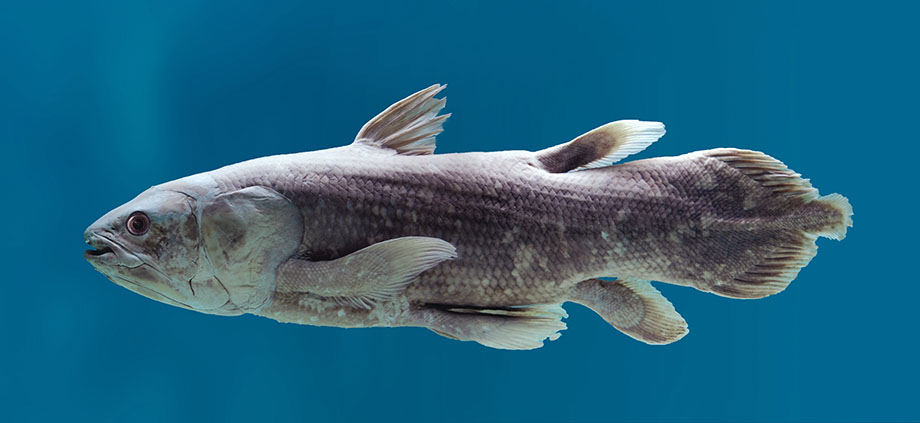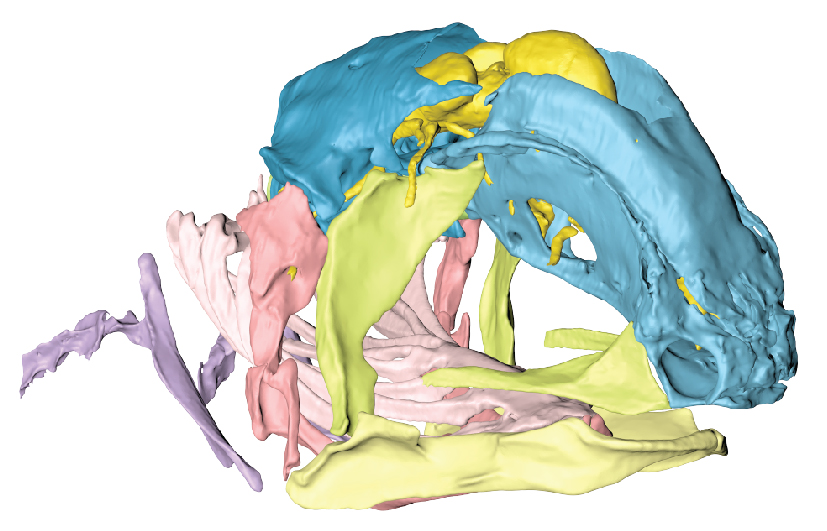- Home
- News
- General News
- Coelacanth reveals...
Coelacanth reveals new insights into skull evolution
17-04-2019
A team of researchers, in conjunction with the National Museum of Natural History in Paris, presents the first observations of the development of the skull and brain in the living coelacanth Latimeria chalumnae. The study, published in Nature, uses data from beamline ID19 and provides new insights into the biology of this iconic animal and the evolution of the vertebrate skull.
The coelacanth Latimeria is a marine fish closely related to tetrapods, four-limbed vertebrates including amphibians, mammals and reptiles. Coelacanths were thought to have been extinct for 70 million years, until the accidental capture of a living specimen by a South African fisherman in 1938. Eighty years after its discovery, Latimeria remains of scientific interest for understanding the origin of tetrapods and the evolution of their closest fossil relatives – the lobe-finned fishes.
One of the most unusual features of Latimeria is its hinged braincase, which is otherwise only found in many fossil lobe-finned fishes from the Devonian period (410-360 million years ago). The braincase of Latimeria is completely split into an anterior and posterior portion by a joint called the “intracranial joint”. In addition, the brain lies far at the rear of the braincase and takes up only 1% of the cavity housing it. This mismatch between the brain and its cavity is totally unequalled among living vertebrates. How the coelacanth skull grows and why the brain remains so small has puzzled scientists for years. To answer these questions, researchers studied specimens at different stages of cranial development from several public natural history collections.

Coelacanths live in the deep ocean and are a critically endangered species.
Although many specimens of adult coelacanths are available in natural history collections, earlier life stages such as foetuses are extremely rare. Scientists hence used state-of-the-art imaging techniques to visualise the internal anatomy of the specimens without damaging them. They notably digitalised a 5 cm-long fetus, the earliest developmental stage available for Latimeria, using synchrotron X-ray microtomography on beamline ID19.
These data, along with those from MRI and micro-CT scanning techniques, were used to generate detailed 3D models, which allowed scientists to describe how the form of the skull, the brain and the notochord (a tube extending below the brain and the spinal cord in the early stages of life) changes from a foetus to an adult. They also observed how these structures are positioned relative to each other at each stage, and compared their observations with what is known about the formation of the skull in other vertebrates.
In contrast to most other vertebrates, where the notochord is replaced by the vertebral column early in embryonic development, the notochord expands considerably in Latimeria. The dramatic enlargement of the notochord likely influences the patterning of the braincase, and might underpin the formation of the intracranial joint. The brain might also be affected by the enlargement of the notochord, as relative size dramatically decreases during development.

Overall anterolateral view of the skull of the coelacanth foetus imaged on beamline ID19. The brain is in yellow. Credit: H. Dutel et al.
These results illuminate for the first time the development of the living coelacanth skull and brain, and open up new avenues for research on the evolution of the vertebrate head.
Hugo Dutel, lead author and research associate in palaeobiology at the University of Bristol, UK, said, “These are very unique observations but they represent only a tiny step forward compared to the amount we know on the development of other species. There are still more questions than answers! Latimeria still holds many clues for our understanding of vertebrate evolution, and it is important to protect this threatened species and its environment.”
Reference
Dutel, H. et al., Nature (2019); doi: 10.1038/s41586-019-1117-3
Text: Anya Joly
Top image: A living coelacanth Latimeria chalumnae. Credit: Laurent Ballesta, Gombessa expeditions, Andromede Oceanology Ltd.



